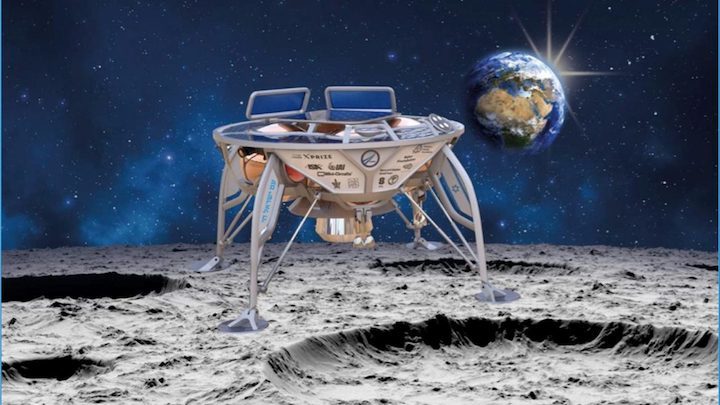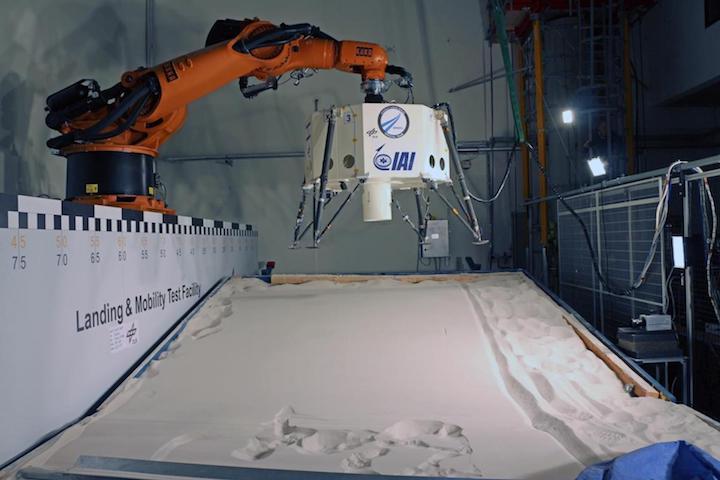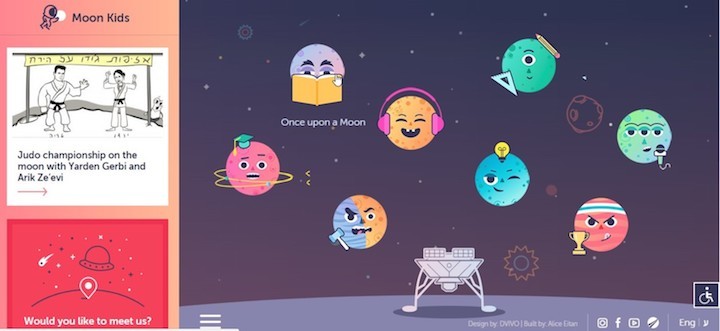2.04.2018
The Google Lunar X prize may have expired on March 31, but SpaceIL plans to launch on a SpaceX Falcon 9 via Spaceflight Industries in Q4 2018.

SpaceIL’s lunar module on a simulated moon backdrop. Photo: courtesy
.
The Google Lunar X Prize competition expired on March 31 with no winner. Yet Israel’s team, the nonprofit SpaceIL, is continuing its mission of landing an unmanned module on the moon – with plans to launch on a SpaceX Falcon 9 via Spaceflight Industries in the fourth quarter of 2018, even if Lunar X does not find another major sponsor.
“We are moving forward with the project, regardless of the terms or status of the Google Lunar X Prize,” said newly appointed SpaceIL CEO Ido Anteby, formerly of the Israel Atomic Energy Commission.
“SpaceIL and Israel Aerospace Industries are committed to landing the first Israeli spacecraft on the moon, and we plan to launch before the end of this year.”
So far, only three world superpowers, the United States, Russia, and China, with their tremendous resources, have achieved controlled lunar landings.
“Our mission was never about winning the prize money – although $20 million would have been nice,” said Anteby. “It’s about showing the next generation that anything is possible – that even our small country can push the limits of imagination.
“The impact of our spacecraft’s launch and its historic weeks-long journey to land on the moon will resonate for years to come, and we hope to inspire new forays into science, technology, and space exploration.”
SpaceIL was Israel’s entry in the Google Lunar X Prize Moon Race, started in 2007 to inspire innovators from around the world to develop low-cost methods of robotic space exploration.
To win the $20 million grand prize, a privately funded team had to have been the first to successfully place a spacecraft on the moon’s surface, travel 500 meters on the moon, and transmit high-definition video and images back to Earth – all before the competition’s deadline, March 31, 2018.
SpaceIL was the first of 16 competitors to sign a launch contract and one of only five teams to proceed in the contest.
Systems tested, landing location chosen
The mission’s scientist, Prof. Oded Aharonson of the Weizmann Institute of Science, has helped the team determine that the spacecraft should aim to land on Mare Serenitatis, (Serene Sea) an area in the moon’s northern hemisphere.
This site has a strong magnetic field that will allow the magnetometer aboard the spacecraft to take measurements and collect data about its characteristics during the landing, and transmit these back to Earth.
The engine and fuel tanks were recently integrated into the spacecraft’s body inside the “clean room” at IAI’s space facility. “In parallel, we are making progress with our simulator system, with the navigation control software development, with the ground control stations and with the preparations for testing the spacecraft and its subsystems,” Anteby reported.

-
The craft’s cameras successfully passed an environment test in which they were placed in a vacuum chamber simulating the extreme temperatures that the spacecraft will encounter during its voyage. They’re now being integrated into the craft.
SpaceIL has signed a contract for satellite communication services to keep track of the location of the spacecraft on its journey to the moon. Members of the team also went to Cape Canaveral in Florida to begin coordinating with all the entities taking part in the launch, particularly SpaceX, and to see the large hangar where the spacecraft will undergo its last pre-launch tests and will be fueled.
Inspiring future scientists in Israel and beyond
As for SpaceIL’s mission to inspire young people to explore STEM subjects, the nonprofit is telling its story to 500,000 children nationwide through a volunteer network, and has chosen 100 schools to take part in “Moon Games,” a unique educational program in collaboration with the Israel Space Agency.
SpaceIL recently sponsored an activity at the Holon Technological Fair for 30,000 Israeli ninth-graders, “Do you have what it takes to build a spacecraft that will land on the moon?” that presented the young visitors with various challenges involving creative thinking, spatial vision, mathematical thinking and more.
Israeli kids flying on El Al during the Passover season will receive the third issue of SpaceIL’s fun workbook series, Who Wants to Reach the Moon? on the theme of “Women in Space.”
And for children from any country, SpaceIL has introduced its Moon Kids website in English, chock full of fun interactive content about the moon and outer space.

Screenshot from the Moon Kids website.
Quelle: ISRAEL21c
